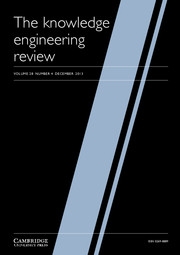Crossref Citations
This article has been cited by the following publications. This list is generated based on data provided by
Crossref.
Kobsa, Alfred
1991.
Preface.
User Modeling and User-adapted Interaction,
Vol. 1,
Issue. 1,
p.
v.
Kok, André J.
1991.
A formal approach to user models in data retrieval.
International Journal of Man-Machine Studies,
Vol. 35,
Issue. 5,
p.
675.
Wasson, Barbara
and
Akselsen, Sigmund
1992.
An overview of on-line assistance: from on-line documentation to intelligent help and training.
The Knowledge Engineering Review,
Vol. 7,
Issue. 4,
p.
289.
Kaplan, Craig
Fenwick, Justine
and
Chen, James
1993.
Adaptive hypertext navigation based on user goals and context.
User Modeling and User-Adapted Interaction,
Vol. 3,
Issue. 3,
p.
193.
McTear, Michael F.
1993.
User modelling for adaptive computer systems: a survey of recent developments.
Artificial Intelligence Review,
Vol. 7,
Issue. 3-4,
p.
157.
Medyckyj-Scott, D.J.
Newman, I.A.
and
O'Brien, S.M.
1993.
GENIE: a global environmental network for information exchange.
Journal of Information Science,
Vol. 19,
Issue. 5,
p.
403.
Benyon, D.
and
Murray, D.
1993.
Adaptive systems: from intelligent tutoring to autonomous agents.
Knowledge-Based Systems,
Vol. 6,
Issue. 4,
p.
197.
Keravnou, E.T.
Washbrook, J.
and
Dams, F.
1993.
Towards competent information acquisition interactions between an expert system and its user.
Knowledge-Based Systems,
Vol. 6,
Issue. 3,
p.
141.
Kobsa, Alfred
1993.
Grundlagen und Anwendungen der Künstlichen Intelligenz.
p.
152.
Mikulecký, Peter
1994.
Human-Machine Communication for Educational Systems Design.
p.
213.
Brusilovsky, Peter
1996.
Multimedia, Hypermedia, and Virtual Reality Models, Systems, and Applications.
Vol. 1077,
Issue. ,
p.
288.
Brusilovsky, Peter
1996.
Methods and techniques of adaptive hypermedia.
User Modeling and User-Adapted Interaction,
Vol. 6,
Issue. 2-3,
p.
87.
Brusilovsky, Peter
1998.
Adaptive Hypertext and Hypermedia.
p.
1.
Kaplan, Craig A.
Chen, James R.
and
Fenwick, Justine R.
1998.
Adaptive Hypertext and Hypermedia.
p.
45.
Chu, W.W.
Johnson, D.B.
and
Kangarloo, H.
2000.
A medical digital library to support scenario and user-tailored information retrieval.
IEEE Transactions on Information Technology in Biomedicine,
Vol. 4,
Issue. 2,
p.
97.
Arruarte, Ana
Ferrero, Begoña
Fernández-Castro, Isabel
Urretavizcaya, Maite
Álvarez, Ainhoa
and
Greer, Jim
2003.
Authoring Tools for Advanced Technology Learning Environments.
p.
233.
Uther, M.
Zipitria, I.
Uther, J.
and
Singh, P.
2005.
Mobile adaptive CALL (MAC): a case-study in developing a mobile learning application for speech/audio language training.
p.
5 pp..
Jung, Jason J.
and
Pham, Xuan Hau
2011.
Computational Collective Intelligence. Technologies and Applications.
Vol. 6922,
Issue. ,
p.
592.
Jung, Jason J.
2012.
Attribute selection-based recommendation framework for short-head user group: An empirical study by MovieLens and IMDB.
Expert Systems with Applications,
Vol. 39,
Issue. 4,
p.
4049.
Medina-Medina, Nuria
and
García-Cabrera, Lina
2016.
A taxonomy for user models in adaptive systems: special considerations for learning environments.
The Knowledge Engineering Review,
Vol. 31,
Issue. 2,
p.
124.

